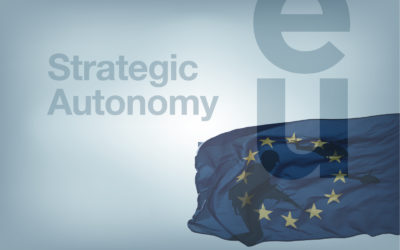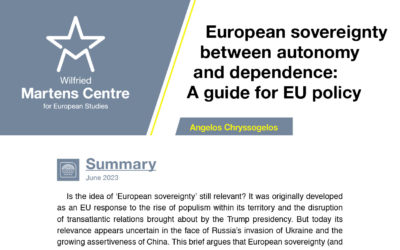 Loading...
Loading...-
Europe is at a critical crossroads. In the face of increasing instability, from Russia’s war in Ukraine to growing tensions in the Sahel and Indo-Pacific, it is clear that Europe’s traditional defence model, based on national spending and isolated military strategies, is no longer sufficient. The fragmented approach to defence spending has led to inefficiency, redundancy, and, most dangerously, a lack of cohesion in our collective defence efforts. If Europe is to secure its future, we must act together, pooling our resources to build a common defence effort that strengthens our strategic autonomy and industrial base.
National defence spending creates a paradox. Governments are under pressure to ensure that every euro spent on defence boosts national employment and GDP. This leads to investments driven by national interests rather than collective needs, encouraging inefficiency, through fragmented standards and multiple production platforms, and reducing the potential for cross-border collaboration. Worse still, some policies deepen synergies with US forces, rather than with European partners, weakening Europe’s unity and its ability to act independently during crises. It is not about denying the importance of NATO in our defence imperative, yet this reality weakens Europe’s unity and compromises its ability to act independently in times of crisis. This is where we must change course.
The solution lies in a collective effort: shared EU borrowing for defence. This isn’t just about funding; it’s about creating a European defence strategy where investments complement one another, rather than duplicating efforts, and developing interoperable capabilities across the Union. The ReArm Europe initiative, proposed by the European Commission, is a step in the right direction. Yet, it will only work if we move beyond national interests and adopt a shared borrowing mechanism that is not based on mere accounting transfers and is significantly greater than the 150 billion euros proposed by the Commission.
What would such an approach look like? By pooling resources, Europe could invest in large-scale, cross-border defence projects, enhancing security and ensuring interoperability across the continent. A European Defence Bond, similar to those issued during the pandemic recovery, could provide the necessary financial framework. This would enable countries to focus on strengthening air and missile defence, and developing cutting-edge technologies such as artificial intelligence, alternative fuels for military use, and autonomous guidance systems.
Through collective procurement, the EU could achieve economies of scale, reducing costs and ensuring resources are used efficiently. Shared borrowing would also open the door for dual-use technologies, allowing civilian industries, like those involved in cybersecurity, AI, robotics, and space technologies, to contribute to defence efforts. By integrating these technologies into our defence strategies, we could ensure Europe remains at the forefront of global defence innovation, reducing reliance on external powers.
This model is about more than just military efficiency. It’s about ensuring Europe’s economic security is not undermined by fragmentation. By aligning defence industries, we can strengthen the EU’s industrial base, create high-tech jobs, and reduce dependence on foreign suppliers. However, the largest industrial capacities are currently concentrated in France, Germany, and Italy. To avoid the risk of re-fragmentation following political changes, military industrial capacities must be fully decentralised across the EU. This is a condition for ensuring a stable and long-lasting military production capacity.
Moreover, this shared effort would provide the EU with the long-term strategic flexibility that we currently lack. National defence budgets are often subject to changing political winds, preventing long-term planning. Shared borrowing would allow for consistent investments, ensuring the EU can respond to emerging threats, such as cyber-attacks, hybrid warfare, or new conventional military challenges.
This is not just about strengthening Europe’s military; it’s about preserving European values in an increasingly uncertain world. The EU must take charge of its security and demonstrate that we can act decisively without relying on external powers. With a common European defence strategy, supported by shared resources, we can build resilient, interoperable forces capable of responding to any crisis.
Europe must move beyond the fragmentation of national defence efforts and embrace a collective approach to security. Europe’s future depends on our ability to act as one. By pooling resources and investing in shared defence capabilities, we can secure Europe’s place in a rapidly changing world.
The choice is clear: continue with the outdated model of national silos or unite to build a stronger, more autonomous Europe. Let’s act together now.
Radan Kanev Defence Strategic Autonomy

Radan Kanev
Why Europe Must Embrace Common Borrowing for its Strategic Autonomy
Blog
03 Apr 2025
-
Is the idea of ‘European sovereignty’ still relevant? It was originally developed as an EU response to the rise of populism within its territory and the disruption of transatlantic relations brought about by the Trump presidency. But today its relevance appears uncertain in the face of Russia’s invasion of Ukraine and the growing assertiveness of China. This brief argues that European sovereignty (and related concepts such as strategic autonomy) is still an important and necessary guide for EU policy, but only if it is dissociated from some of the excessive and overambitious definitions given to the concept when it was first developed. European sovereignty is bound to fail if it is defined as taking an equidistant position between the US and China or as aiming for the atavistic goal of autarky in all conceivable policy areas, from security and energy to economy and technology. Instead, the brief argues, European sovereignty must be understood as a moderate and pragmatic agenda of defending EU interests and priorities within the wider framework of the transatlantic relationship, protecting the EU’s internal liberal political and economic order, and defending international openness where the EU still has comparative advantages. Most of all, the necessary objective of protecting European sovereignty against external forces must not become a backdoor for the undue centralisation of political and economic power inside the EU, a process that would be bound to generate new populist reactions and constrain the EU’s room of manoeuvre internationally. The brief concludes by proposing an understanding of European sovereignty as a compound term, containing both the ideal of EU autonomy of action internationally and the protection of the Union’s internal heterogeneity, diversity and level playing field. Understood in this way as a ‘sovereignty of sovereignties’, European sovereignty can serve as an important guide for EU policy.
Foreign Policy Sovereignty Strategic Autonomy
European sovereignty between autonomy and dependence: A guide for EU policy
Policy Briefs
22 Jun 2023


